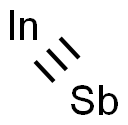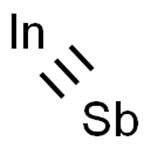Chemical Properties
Crystalline solid.
Physical properties
Black cubic crystal; zincblende structure; density 5.775 g/cm3; melts at525°C; density of melt 6.48 g/mL; dielectric constant 15.9; insoluble in water.
Uses
Indium antimonide finds use in infrared detectors, including FLIR systems, thermal imaging cameras, infrared astronomy and in infrared homing missile guidance systems, in fast transistors. It is used in thermal image detectors using photo-electromagnetic detectors or photodiodes.
Uses
Crystal structure: Zinc blende structure, cubic
Uses
In semiconductor electronics. Grown p-n junctions(Indium(III) antimonide) have been made by doping a melt with an acceptor impurity such as zinc or cadmium, and dipping in an n-type crystal. Rate-grown junctions have also been made. Broad-area surface junctions have been produced by out-diffusing antimony in vacuum from the surface of an n-type crystal, producing a p-n junction just inside the surface. Also has photoconductive, photoelectromagnetic, and magnetoresistive properties. Useful as an infrared detector and filter, and in Hall effect devices.
Preparation
Indium antimonide may be synthesized from its elements by fusion of sto-ichiometric amounts of indium and antimony at elevated temperatures in anevacuated, sealed ampule.
Production Methods
Intermetallic semiconductors of indium are formed from
group III and group V elements, requiring very high purity
of the elements (0.1 ppm).
Production Methods
Single crystals are grown by using the Kyropoulus method—by pulling up from the melt composed
of stoichiometric In and Sb because both elements have low vapor pressure. Impurities are Zn and
Cd, which cannot be removed by zone refining. As a result, it is important to use pure source
materials. It is soft and fragile, and it is required to be cut carefully by a diamond cutter. The same
polishing method for Si and Ge is possible.
Films are deposited using the vapor phase method. In and Sb (or In(CH3) and SbH3) are
encapsuled in a vacuum and these source materials are heated to evaporate and then deposited
on the substrate placed at a lower temperature portion. The electrical properties of the films
deposited by this method are slightly different from those of bulk.
General Description
This product has been enhanced for energy efficiency.
Hazard
See indium; antimony.
Structure and conformation
The space lattice of InSb belongs to the cubic system and zinc-blende-type structure called InSb-I
at room temperature and under atmospheric pressure has a lattice constant of a=0.64789 nm and
In–Sb=0.280 nm. A single crystal has cleavage of (110) plane. It transforms to white tin-type
InSb-II at high temperatures and under high pressure.




